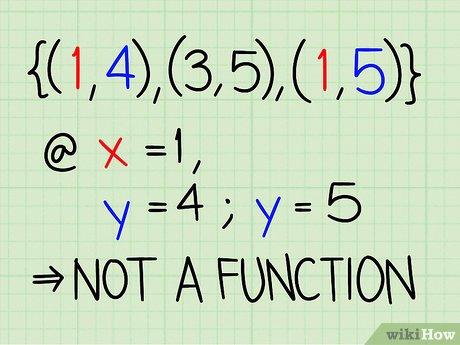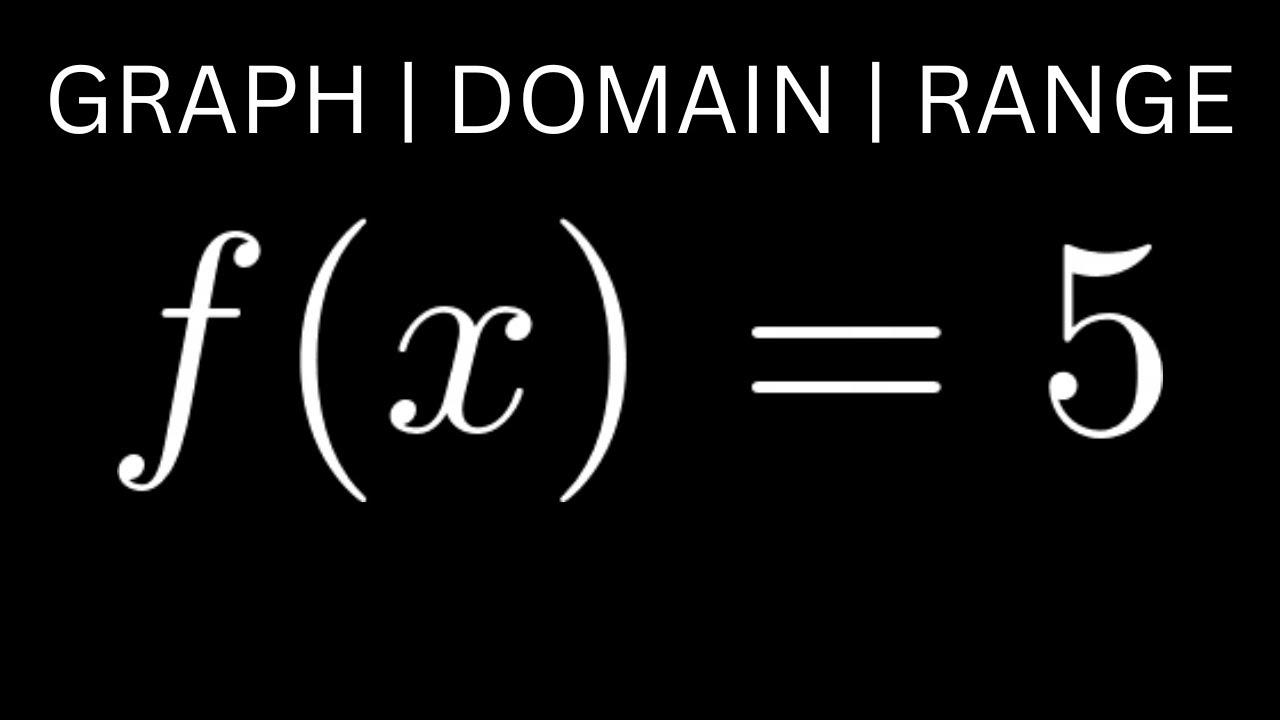Table of Contents
- Understanding the Concept of Domain of 5 in Mathematics
- Exploring Practical Applications of Domain of 5 in Real Life
- Key Strategies for Teaching Domain of 5 Effectively
- Common Misconceptions about Domain of 5 and How to Address Them
- Resources and Tools for Mastering Domain of 5 Concepts
- Q&A
- Future Outlook


Understanding the Concept of Domain of 5 in Mathematics
In mathematics, the domain of a function represents all the possible input values that will not lead to any contradictions or undefined scenarios. When examining the domain of 5, particularly in relation to a function, one must define what sort of function is in focus. For instance, when conceptualizing the function f(x) = 5, the domain spans all real numbers because the function generates a constant output, regardless of the input. This characteristic creates a scenario where every real number can be plugged into the function without ever resulting in an undefined value.
Another fascinating aspect relates to functions that include the number 5 in more complex expressions. Consider functions such as f(x) = x/5, where the input x can be any real number except for zero. Given that division by zero is undefined, the domain here would exclude 0, thereby creating a more confined set of valid inputs. Hence, a better understanding of the function’s structure leads to the insight that the domain must reflect any restrictions imposed by the mathematical operations within the function:
| Function | Domain |
|---|---|
| f(x) = 5 | All real numbers (ℝ) |
| f(x) = x/5 | All real numbers except 0 (ℝ – {0}) |
| f(x) = 5/x | All real numbers except 0 (ℝ – {0}) |
Another important consideration is the implications of defining a specific domain for expressions containing the number 5. For example, when establishing inequalities involving the number 5, such as 2x < 5, the viable domain can be determined by solving for x. In this case, the solution restricts x to values less than 2.5, showcasing how the concept of domain is vital in determining where functions remain valid. Recognizing these nuances around the domain encourages a more profound appreciation for the rigid structure mathematics can offer while still allowing for creative problem-solving.
Exploring Practical Applications of Domain of 5 in Real Life
Understanding the concept of Domain of 5 allows for an enriched perspective across various fields. In educational contexts, for instance, applying this domain fosters critical thinking by encouraging students to explore concepts at a deeper level. Math educators often use the domain to break down complex problems, allowing learners to approach challenges through the lens of division into five distinct parts. This segmentation not only enhances comprehension but also empowers students to tackle bigger ideas by understanding essential components.
In business settings, the Domain of 5 can serve as a strategic tool for decision-making. Companies can leverage this concept to evaluate options through five key aspects—market demand, resource availability, financial viability, risk assessment, and innovation potential. By categorizing decisions into these parameters, organizations can make more informed choices that align with their goals and operational capabilities. This structured approach mitigates risks and enhances the strategic alignment of initiatives with overarching objectives.
Furthermore, in personal development and goal setting, the Domain of 5 plays a crucial role. Individuals striving for self-improvement can focus on five different domains of their lives—physical health, mental wellness, relationships, career, and personal growth. This holistic approach helps in drafting actionable plans that target each area specifically. By establishing measurable goals within each domain, one can closely monitor progress and adjust strategies as needed, fostering a balanced and fulfilling life.


Key Strategies for Teaching Domain of 5 Effectively
To effectively teach the domain of 5, one crucial strategy is implementing hands-on learning activities. These activities engage students while allowing them to explore concepts through experimenting and practicing. By incorporating materials such as blocks, counters, or interactive tools, educators can help students visualize and understand the relationships between numbers. For example, using everyday items to create groups can illuminate the concept of five in a relatable setting. This experiential learning approach solidifies foundational skills and makes abstract ideas more tangible.
Another vital element is utilizing collaborative learning techniques. By encouraging students to work in pairs or small groups, they can discuss their thought processes and share strategies with peers. This not only fosters a supportive learning environment but also enhances comprehension through social interaction. Group discussions can revolve around problem-solving tasks that require applying their knowledge of the number five, ensuring that each student has the opportunity to articulate their understanding. This method encourages accountability and enables students to learn from one another.
Lastly, integrating technology into lessons can significantly enhance engagement and retention. Consider utilizing educational apps or online games tailored to the domain of 5. These resources often provide instant feedback and adaptive learning paths, catering to various proficiency levels. Additionally, incorporating visual aids such as digital presentations or videos can offer diverse perspectives on the topic, helping to reinforce the concepts. By blending traditional teaching methods with innovative tools, educators can create a multifaceted learning experience that resonates with today’s tech-savvy students.


Common Misconceptions about Domain of 5 and How to Address Them
When discussing the domain of 5, many people mistakenly believe that it refers solely to the traditional concept of five distinct areas or subjects within a field. However, this interpretation is overly simplistic and misses the broader applications. The domain of 5 encompasses not just distinct subjects but also the interconnectedness of various concepts. It’s essential to understand that the emphasis lies not just on the individual components but on how they interact within the larger framework.
Another common misconception is that one must possess extensive expertise in all five areas to be considered knowledgeable or successful. In reality, a more nuanced approach is required. Individuals can thrive by focusing on their strengths while collaborating with experts in other domains. This collaborative approach enhances overall outcomes, leading to richer possibilities and innovations. Consider the following factors:
- Collaboration - Working with peers enhances knowledge exchange.
- Specialization – Focusing on one or two areas can yield greater expertise.
- Flexibility – Adapting to changes in any of the domains is crucial for growth.
Lastly, there is a tendency to undervalue the significance of practical application within the domain of 5. Some individuals falsely assume that theoretical knowledge alone is sufficient. It’s imperative to actively engage in real-world scenarios to fully grasp and appreciate the implications of theoretical concepts. This understanding can often be illustrated through the following table displaying practical applications across the domains:
| Domain | Practical Application |
|---|---|
| Communication | Effective interpersonal skills for better teamwork. |
| Technology | Utilizing software tools to improve productivity. |
| Critical Thinking | Solving complex problems through analysis. |
| Creativity | Developing innovative solutions in projects. |
| Leadership | Guiding teams towards common goals. |


Resources and Tools for Mastering Domain of 5 Concepts
To effectively navigate the complexities of the five essential concepts, leveraging the right resources and tools can make all the difference. Books remain a timeless asset, providing in-depth insights and foundational knowledge. Some noteworthy titles include:
- The Art of War by Sun Tzu – A treatise on strategy and tactics.
- Thinking, Fast and Slow by Daniel Kahneman – An exploration of decision-making processes.
- Drive by Daniel H. Pink – A deep dive into motivation theories.
Online platforms also offer a wealth of information and interactive learning opportunities. Websites like Coursera and edX provide courses created by top universities and organizations that help solidify your understanding of each concept. In addition, consider these valuable resources:
- MindTools – Tools and resources for personal and professional development.
- Khan Academy - Free courses covering a wide array of subjects in an accessible format.
- LinkedIn Learning – An extensive library of video tutorials on business skills.
Utilizing software tools can also enhance your mastery of these concepts. Productivity and project management applications can help you apply what you learn in real-world scenarios. Here’s a quick table summarizing some excellent options:
| Tool | Functionality | Best For |
|---|---|---|
| Trello | Visual task management | Organizing projects |
| Evernote | Note-taking and organization | Research and ideas |
| Miro | Collaborative whiteboarding | Team brainstorming sessions |
Q&A
Q&A on the Domain of 5
Q1: What exactly is the “Domain of 5”? A1: The “Domain of 5” refers to a conceptual framework that encompasses five key areas or dimensions essential for a holistic understanding of any field or subject. These dimensions can vary depending on the context but are often thought to include aspects such as Knowledge, Application, Relationships, Innovation, and Ethics. This framework encourages individuals to explore various perspectives and see how they interconnect.Q2: Why is the Domain of 5 important in learning and development? A2: Understanding the Domain of 5 is vital because it promotes a more rounded approach to education and personal development. By considering all five dimensions, learners can achieve a deeper comprehension of topics rather than just scratching the surface. This not only enhances critical thinking skills but also prepares individuals to tackle real-world challenges more effectively.
Q3: Can you provide examples of how the Domain of 5 can be applied in practice? A3: Certainly! For instance, in a business setting, when developing a new product, one might assess the Knowledge (market research), Application (how the product fits into existing workflows), Relationships (stakeholder engagement), Innovation (unique selling propositions), and Ethics (sustainability and social responsibility). This structured assessment helps ensure that the product meets various criteria and resonates with customers.
Q4: Who can benefit from understanding the Domain of 5? A4: Nearly anyone can benefit—students, educators, professionals, and leaders in various fields can utilize this framework. It’s particularly useful for those involved in strategic planning, project management, or any area requiring multifaceted thinking. By recognizing the interconnectedness of different domains, individuals can enhance collaboration and foster creativity in problem-solving.
Q5: How can one start integrating the Domain of 5 into their daily routine or projects? A5: A great starting point is to consciously apply the Domain of 5 in planning and decision-making processes. Create checklists or frameworks that incorporate each dimension when approaching tasks or projects. Additionally, encourage discussions within teams that explore these five areas, ensuring everyone contributes their insights. Gradually, integrating this holistic perspective will become second nature.
Q6: Are there any pitfalls to be aware of when using the Domain of 5? A6: Yes, while the Domain of 5 is a useful framework, it’s important to avoid becoming overly rigid in its application. Each project or situation might not require equal focus on all five areas; some may need more emphasis on certain dimensions than others. Flexibility and adaptability in applying the framework are key to maximizing its benefits.
Q7: Where can I learn more about the Domain of 5 and its applications? A7: There are many resources available, including books, articles, and online courses that delve into multidimensional thinking and frameworks like the Domain of 5. Additionally, engaging in workshops or networking with professionals in your area of interest can provide practical insights and expand your understanding further.
By asking and answering these questions, readers gain a comprehensive understanding of the Domain of 5 and its relevance in various contexts.

